Two Eurostar trains at the Gare du Midi Channel Terminal © b-europe.com
The years following independence were a time of profound change and progress for Belgium. Infrastructure played a decisive role in the general development of the country. Between 1835 and 1840, the Belgian railway network was expanded and new lines were built in the south of the country. Bogards Station, inaugurated on 18 May 1840 in the city centre, just 400 metres from the Grand Place was the first railway station on the Brussels – Tubize (later Paris) line.
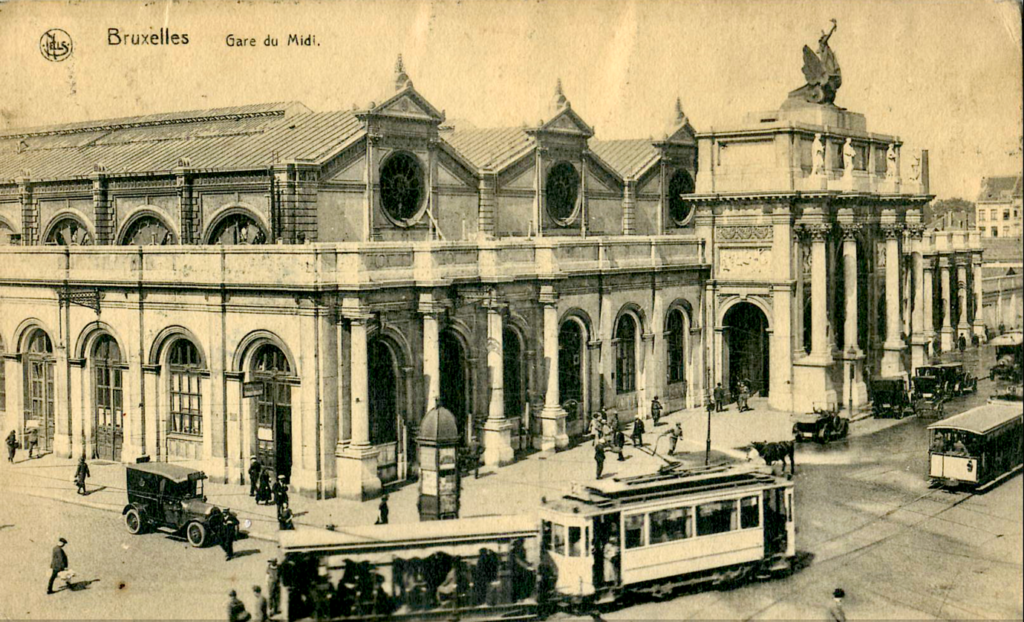
However, the increase in rail traffic soon led to the decision to move the station from the city centre to the municipality of Saint-Gilles, where it was renamed Gare du Midi (Brussels South Station) and inaugurated on 6 November 1869. Built in the neoclassical style, the station is the work of Auguste Payen (1801-1877), one of the first architects commissioned by the Belgian State Railways in 1841. The original station consisted of three main buildings arranged in a U-shape around a hall with a glass roof. The façade with a series of Corinthian porticoes and arcades had a large arch at the entrance, which was decorated with bas-reliefs and statues.
The Gare du Midi was to become the second major railway station in Brussels, alongside the Gare du Nord on the other side of the city, which had been inaugurated 23 years earlier by King Leopold I. Until the beginning of the 20th century, the Gare du Midi and the Gare du Nord were separate, but the constant increase in traffic led to the idea of linking the north and south with a common railway line.
Work on the north-south link began in 1911, but was not completed until 1952 due to the two world wars. In 1949, the former Gare du Midi was demolished with minimal consideration given to its historical value, to make way for a new building in the modernist style. The architects Adrien and Yvan Blomme, together with Fernand Petit, designed the new building with a square clock tower. The modernised Gare du Midi was officially inaugurated on 4 October 1952. The building complex comprised a railway station, a station road, a mail distribution centre and several administrative buildings.
In 1992, the rear section of the station was demolished again to make way for an extension that served as the terminus for the new TGV high-speed train. Today, the Gare du Midi is the largest railway station in Belgium with 22 tracks, including two terminals for Thalys and Eurostar trains. With more and more travellers arriving every year, the station has been extensively modernised and now offers shops and cafés for day tourists.
Brussels-South station, served by Thalys, Eurostar, TGV Brussels-France, ICE and Inter City trains, is now the ideal starting point for journeys to France, Germany, the Netherlands, Luxembourg or Great Britain. As a high-speed railway station in Brussels, it offers convenient and fast connections to the entire Belgian network. Additionally, since 1988, the station has been served by both the metro and a pre-metro networks.
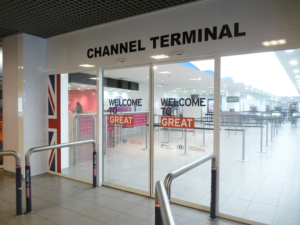
Nowadays however, there has been a constant stream of complaints from tourists and locals alike regarding the increasing levels of filth and crime at Gare du Midi and its neighbourhood. As the station is one of the main gateways for tourists into the city, the public’s dissatisfaction and the growing concern of the authorities are quite understandable.
Many tourists have openly complained about the strong, foul odour surrounding the station and the general feeling of insecurity and lawlessness in the area, which is not very welcoming for newcomers to the city. Especially at night, the situation seems to be even more problematic. People living on the streets and beggars roam around, committing various crimes and robberies because they are in desperate need of money, mostly for alcohol and drugs. This is just one of the recent cases that made headlines earlier this year: one morning in January, a man was stabbed to death with a butcher’s knife in the railway station. The French-language news channel RTL reported that the attacker stabbed his victim while he was screaming. Fortunately, a French police officer who was there and two security guards intervened and brought the man to the ground. The victim, who was lying in a pool of blood, was promptly rushed to hospital.
In the area there are frequent smashed windows and break-ins of cars, looting of small shops and an alarming rise in drug dealing involving increasingly younger people. Although there are police patrols, they are often understaffed, making effective monitoring and enforcement difficult.

Gare du Midi, despite being frequented by tens of thousands of people, presents a desolate scene that urgently requires drastic measures to address the intolerable situation. Police data, recently disclosed by Interior Minister Annelies Verlinden, has revealed that between 2018 and 2022, the Gare du Midi has become a significant crime hotspot, witnessing approximately 10 offenses occurring there on a daily basis. Recent official police figures show that around 150 armed robberies were committed at or near the Gare du Midi last year and a total of around 3,500 crimes, including theft, extortion and drug offences. Many believe that the actual figures are much higher.
The number of offences and misdemeanours recorded in the Gare du Midi area is well above the average for other Belgian cities. With 3,447 offences in 2020 and 3,320 in 2021, there were almost as many offences as in all railway stations in 13 Flemish cities, including Antwerp and Ghent, put together. (Source: De Standaard).
In a recent move, Sophie Dutordoir, CEO of the National Railway Company of Belgium (SNCB), made an appeal to politicians through an open letter addressed to Brussels Minister-President Rudi Vervoort, Minister of Mobility Georges Gilkinet, Interior Minister Annelies Verlinden, as well as Jean Spinette and Fabrice Cumps, respectively the mayors of Saint-Gilles and Anderlecht municipalities. In the letter, she sought their assistance in resolving the “dramatic situation” at the Gare du Midi.

In the letter, she explained that the SNCB did not have sufficient resources to solve the problem on its own and called for the urgent involvement of the authorities. There are numerous responsibilities between the federal government, the regions, the municipalities, the SNCB and the police.
Prime Minister Alexander De Croo has decided to deal with the problem of insecurity at the Gare du Midi himself and to appoint a coordinator for the urgent measures required. The Prime Minister’s Office has brought together various authorities for talks to find a common solution and provide a federal response to these persistent problems that tarnish the international image of the Belgian capital. During a recent police operation targeting security issues both inside and outside the station, approximately sixty individuals were apprehended. Simultaneously, extensive cleaning efforts were undertaken on the sidewalks, resulting in the removal of a substantial quantity of diverse waste from the premises.
The fact that the situation at the Gare du Midi, which has been ongoing for several years, has recently become the centre of attention is mainly due to an article in ‘Het Laatste Nieuws’, Belgium’s largest daily newspaper. The article gave a harrowing account of a family with children who arrived at the train station late at night after returning from a trip abroad via Charleroi airport, with the Gare du Midi being their only connection point to Brussels through a bus ride. During the hours they had to wait for their connecting train, they were exposed to a series of violent crimes, causing them genuine concern for their safety. The family’s testimony, including detailed information and video recordings, was featured on the newspaper’s website. Since then, the Gare du Midi has garnered significant attention in the headlines, particularly in the northern region of the country.
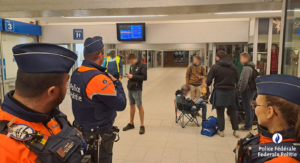
The feeling of insecurity at the Gare du Midi can be partly attributed to factors such as poverty, homelessness and drug dealing. However, it is important to note that the problems go beyond the station itself. According to the Federal Police, crime has increased by 20 per cent overall in recent years, with the problems at the Gare du Midi being much more pronounced.
In response to public pressure, the federal government presented an action plan in August 2023 that sets out 22 concrete measures, based on three main pillars in order to restore security in and around the Gare du Midi. The introduction of new infrastructure around the building was announced, including the establishment of a police station either on the site or in the immediate vicinity. A ban on alcohol consumption within the site was also proposed, as well as plans to reinforce CCTV coverage and surveillance in and around the station.

According to a joint press release from the Belgian Prime Minister and the Minister of the Interior, the task of restoring security at the Gare du Midi in Brussels will be overseen by the national crisis centre. The main priorities include combating criminal and illegal activity in and around the station, tackling homelessness, combating drug addiction and improving cleanliness in the area.
Under the coordination of the National Crisis Centre (NCCN), the federal, regional and municipal authorities and the SNCB have committed to working more closely together to keep the situation under control and improve it as quickly as possible. The ‘Crisis Centre’ will coordinate everything without replacing the relevant services and authorities. Its role is limited in time, and only until the habitability and safety plan has been fully developed.
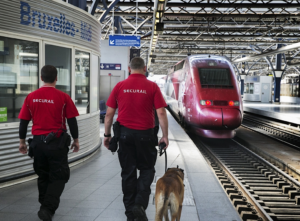
However, the police unions are quite cautious and have no great expectations of the recently announced measures. They pointed to various problems, many of which have been brewing for years and which cannot be fully resolved by the recently announced measures. At the same time, they emphasised that efforts must not slacken when public attention and pressure wane.
Vincent Houssin, vice-president of the VSOA/SLFP police union, said in an interview in September 2023: “The police are destitute and the problems have been neglected for years. If we clean up Brussels South, we only risk shifting the problem to other regions. There are other problematic railway stations in Belgium. We have been hearing for years that the situation in Brussels-North is unbearable. Just last year, a colleague was stabbed to death there, but that hasn’t changed much. We need more resources, infrastructure and staff, there is a shortage of at least 2,500 employees”. (Source: BX1.be)
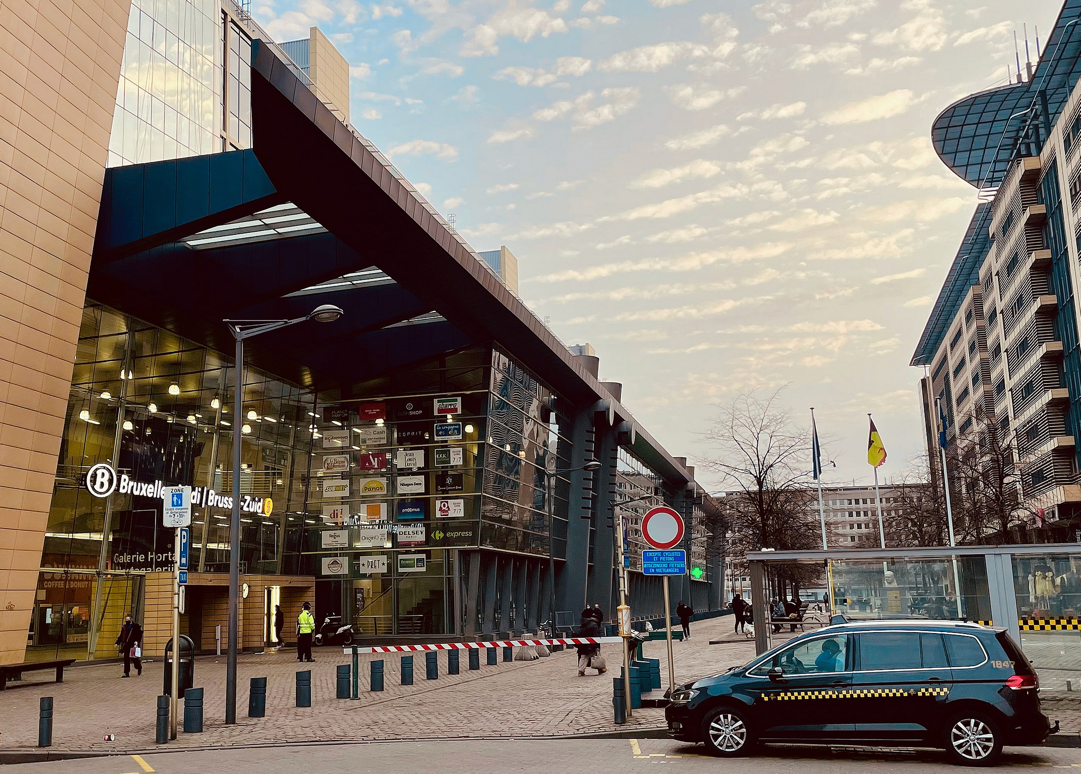
The members of CORES (Brussels Regional Security Council) have also called for the rapid implementation of measures to receive asylum seekers, which should lead to a reduction in the number of people present in the areas in question.
As a result of all these efforts and measures, people have recently noticed some improvement in the situation, depending on the time of day and in terms of police presence. However, the feeling of insecurity remains, especially in the early hours of the morning when people roam the streets and pickpockets are out and about.
There is a consensus among all that the safety of citizens should be the top priority for authorities. At the same time, it is widely acknowledged that major cities around the world grapple with the issue of high crime rates, particularly in the vicinity of central stations where people from all walks of life converge. Tourists, in particular, are often targeted by pickpockets in such areas. Unfortunately, acts of naivety and carelessness often result in negative outcomes for individuals.
However, it is absolutely unacceptable to feel fear when crossing a station at certain times or to be the victim or witness of an attack in the city centre. Such incidents are not only detrimental to tourism in Brussels, but also to the city’s image as the heart of Europe. It is imperative that swift and decisive action is taken to bring about meaningful change.

